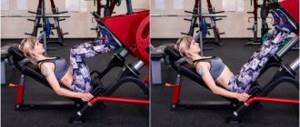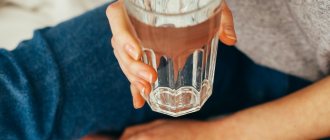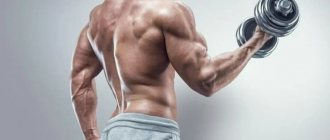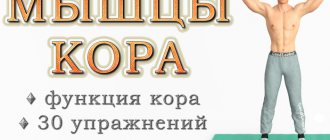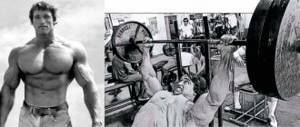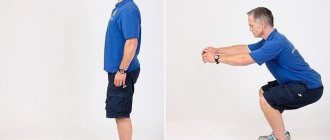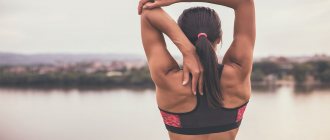For beginners: the simplest training
Here is one of the simplest sets of Pilates exercises. How to do:
- You need to lie on your back (it is advisable to place a mat on top). Stretch your arms along the body, bend your legs at the knees. As you inhale, lifting your buttocks off the floor, you need to slowly arch your back so that your body from your shoulders to your knees is a straight line. In the upper phase of the exercise, you need to inhale. This is followed by the same slow return to the starting position as you exhale. The exercise must be repeated ten times.
- This exercise is called "scissors". The starting position is unchanged. One leg, bent at the knee, must be raised up to an angle of more than 90 degrees. The lower back should be pressed against the floor surface. As you exhale, the legs change (in the air). Toes can touch the floor. You need to do 20 repetitions on each leg.
- The next exercise is called the “dying swan”. To perform it you need to lie on your stomach. Legs are extended, socks too. The arms are bent at the elbows, and the palms are slightly higher than the shoulders and rested on the floor. Inhale, and as you exhale, smoothly lift the upper part of the body with emphasis on the palms. While inhaling, a slow descent is made. The rise should not be too high - the lower ribs do not come off the floor surface. The task is not to make the maximum lift, but to stretch out (lengthen). You cannot lift your legs off the floor, but you must strive to stretch the spinal column. The exercise is performed 10 times.
- The so-called “swimming” closes the complex of Pilates exercises. It strengthens the muscles along the spinal column. To perform it you need to get on all fours. The shoulders are located above the hands, and the hip joint is strictly above the knee. The stomach is tucked and the lower back is straight. Inhale, and as you exhale you need to slowly tear off the opposite leg and arm and smoothly stretch them out. Then the same slow return follows. Next, repeat with other limbs. The stomach and lower back should not collapse. And so 20 repetitions.
After the third and fourth exercises, you need to relax as much as possible. To do this, you need to rise from the starting position, kneeling, then sit down so that your buttocks are on your heels. Bend your body forward as far as possible, with your arms extended. The head practically touches the floor.
Useful tips when doing exercises
— Always keep your core (abs) muscles in good shape.
- Concentrate on performing various exercises. Try to do them as correctly as possible. Otherwise, an incorrectly performed pose can harm the body.
— At the very first lesson, the instructor will explain to you how to breathe correctly when performing this or that exercise. Let us only note that we try to inhale deeply through our chests and contract our muscles as we exhale.
— We keep our heads straight, our shoulders lowered, and we try to stretch our spine throughout the entire complex.
All these recommendations will help us learn to breathe correctly and work those muscle groups that we did not know about.
Best for those just starting out
A good complex should cover as many muscles as possible. This is what the best complex for beginners at home looks like:
- Touching the toes of both feet. To do this, you need to lie on your back, while the spinal column should be in a neutral state, that is, some space remains between the surface of the mat and the lower back. The knees are bent, the feet rest on the floor, and the heels are in line with the buttocks. As you exhale, you should alternately raise your legs up with your knees bent at an angle of 90 degrees. With each exhalation, you need to touch the surface of the mat with your toes. The leg lowers as close to its surface as possible, while the back remains in a neutral position. As you exhale, the leg rises again. 10 repetitions on each leg.
- “Coordination” or abs, period. The exercise is performed lying on your back, arms along the body, knees bent, feet on the mat. Alternately lifting legs at right angles. The elbows are also bent at a 90° angle. While exhaling, you need to perform a smooth rise in the following sequence: head, neck, shoulders, while the bottom of the chest should be on the floor. At the same time, the arms and legs are extended forward. As you inhale, spread your legs (wider than your shoulders) and move again. After exhaling, the legs need to be returned to their original position, but the upper body remains in the lifting position. After inhaling the “trio”, the “head-neck-shoulders” lower to the floor. 8 reps. In a simplified version, the legs remain bent - only the torso moves.
- Side plank (with rotation). Lie on your side with your left forearm under your left shoulder and your right arm extended toward the ceiling. Hip, waist in side plank position. In this case, you should not raise your shoulder, but only your hip and side. Putting your right hand under the body (into the gap), you need to make a turn. Lower your hip. 8 repetitions on each side.
- Knee raises. You need to get on all fours. Toes touching, back straight, shoulder blades in line with the spine. After exhaling, you need to pull in your stomach and lift your knees off the floor to a very small height. Keep your back in one position while raising your knees, which are held for two breaths, and the stomach is drawn in with each exhalation. Then your knees need to be lowered onto the mat. 5 reps.
- Circular movements that use the inner thigh muscles. You need to lie on your left side, your left leg is extended, your right leg is bent at the knee joint and lies on the surface of the mat. The left leg needs to be raised to a height of 15 centimeters. The muscles of the left thigh (internal) carry out circular movements of the leg as if the thumb is a kind of spoon that stirs tea in a very large cup. Do 10 circles in both directions, then do the same with the right leg. You can use a small weight attached to your ankle.
- "Hit". Lie on your side, stretch your legs forward. The top hand rests on the mat for support. Inhale, and as you exhale, raise your leg (upper) a few centimeters. Take two breaths while swinging your leg forward and fixing your pelvis in one position. Then exhale and smoothly move the leg beyond the line of the body. 12 repetitions on each leg. You can use small weights on your legs by attaching them to your ankle.
- “Bridge” by raising your legs. Lie on your back with your knees bent and your feet on the floor shoulder-width apart. You need to rest your feet to lift your hips, while keeping your back in one position. Stretch your right leg up, then lower it, remembering to keep your pelvis raised. Raise your leg again. 8 repetitions.
- "Batman" - leg raises. Lie on the floor on your side, legs straight, toes pointed out. The top leg is turned out so that the foot is pointing towards the ceiling. It needs to be lifted while rotating. The stomach is pulled in. 12 reps on each side.
- "Flight". You need to lie on your stomach, hands near your hips. Then stretch your arms back, slightly raise your upper back, keeping your lower back straight. You need to feel how your head stretches upward and your arms go back. Descend. 8 reps.
- Press (T-shaped). Lie on your stomach, arms straightened on the same axis as your shoulders - form the letter “T”. Raise your arms up 5 cm, and move your head, neck and shoulders forward and up. Next, we pull our hands to our hips. Then lower your arms and body and return to the starting position. 8 reps. To make it more difficult, you can use a half-kilogram weight.
- "Swimming". This exercise has already been described above.
- "Clam." Lie on your side with your knees bent and pressed together. Having closed your feet together, you need to rotate your upper leg so that your knee can be raised as high as possible while your pelvis is stationary. Then lower your leg like a clam, as if opening and closing a shell. 15 reps. To make it more difficult, you can wrap an elastic band around your thighs around the circumference.
- Lifting your leg back and up using an elastic band. You need to lie on your left side, bend your knees. An elastic band is attached to the left thigh. The foot of the right leg presses on the band, and the leg is stretched back and up - the leg straightens, overcoming the resistance of the band (the knee extends). The main stretch occurs at the moment when the hip rises to the end. Next, the leg lowers and bends again until it returns to its original position. 12 repetitions on each leg.
- “Bridge” (with one leg lift). Lying on your back, bend your knees, legs slightly apart, and arms along your body. As you exhale, raise your hips, back and chest, supporting yourself on two legs, standing in the famous “bridge.” Lifting your right leg off the surface of the mat, bend it at the knee - it should be higher than the hip, and the shin should be parallel to the surface of the floor. Next, the hips are raised by supporting the left leg - the hamstrings and buttocks work. The hips are at the same level, and the pushes are small to work the muscles of the legs and buttocks (but not the back). 12 reps. Then you need to change the position of your legs and do the same for the other side. Do 2 sets.
- "Chest expander" (perfect posture). Stand up straight, holding a dumbbell in each hand (to make the exercise easier, you don’t have to use dumbbells). Bend your knees, tilt your body forward. The back should be straight, arms with or without dumbbells should be lowered down. Move your arms back a little further than your hips. Then return to the starting position. 15 reps.
- "Circles" with your hands. The starting position is the same as in the previous exercise, with the same dumbbells in your hands. You need to raise your arms in front of you, and then spread them to the sides - you get something like the letter “T”. Lower them down, as if completing a circle. In this case, you need to tense your abdominal muscles and keep your back straight, without slouching.
- "Removing foam." Stand up straight. There is an elastic band in your hands, palms facing up, elbows bent to a right angle. The arms are pressed to the body from shoulder to elbow, but curl slightly when the band is stretched. You need to spread your arms so that your shoulder blades do not move. Next, return to the starting position. 12 reps.
- Push ups. Starting position – standing. Then the body is bent in half, and the hands touch the floor. “Steps” are taken with the hands until the athlete moves in this way to the “lying emphasis” position. Then, there is one push-up from the floor, and a return to the starting position in the reverse order. 8 reps. To make it easier, you can kneel down.
Tips for beginners: how to prepare for training at home
There is time
First of all, you need to understand that it is mandatory to perform all the physical elements according to the method , especially since it is possible to do it slowly at home. It often happens that we miss those moments that do not suit us or that we do not understand. Take some time to figure out what you need to do your job. Experiment with exercises that you don't fully understand.
Try to understand what they are for and why they didn't work before. You may make discoveries that will take your Pilates to the next level.
Home practice is a way to carefully study the instructions that you will find on our website or in books, or watch fitness videos.
Nobody's watching
Have you ever had an instructor correct you before you even had a chance to figure out what the exercise was? It's annoying sometimes, isn't it? Still, sometimes we need to look a little stupid before we do something right.
Nobody will find fault with you. Other practitioners who may cast sidelong glances at you when you are about to repeat another attempt to do a basic exercise correctly, or the instructor. Home is a chance to practice and perfect every move without fear of looking stupid.
Become One with Pilates
When you go to the gym, this sport takes up very little space in your life: when the lesson ends, the time spent with this type of fitness ends. When you do fitness, you intertwine your practice and your personal life with thin threads. This may influence your attitude towards sports. It's like expressing yourself as a whole, which is sure to spark motivation!
Train at a convenient time
If you get used to working independently in Pilates, you will not depend on someone else. You can choose a convenient time to stay on track.
Recommended lesson schedule: 2-4 lessons per week . Even if you visit a physical education studio a couple of times a week, then no one is stopping you from adding a couple more home workouts!
To lose weight
Many people start doing Pilates to lose weight. Training for weight loss at home:
- Stand straight, arms along the body. Bend forward, hands touching the floor, do not bend your knees. After this, in a fixed position, take 3 steps forward with your hands. Fixation again, now fifteen seconds. Then lower your buttocks to the floor, raise your head and bend your back - hold for 15 seconds. Return to the starting position in reverse order. 25 reps.
- Lie on your side and tighten your abs. The upper leg rotates in a circle without bending the knee. Perform for one minute. Then change your leg (lie on the other side) and do the same.
- Lie on the floor, arms extended along the body, tense your abdominal muscles. Using only your buttocks, raise your legs together with your upper body. 15 reps.
- The already familiar “swimming” is also often included in a weight loss complex.
- Lie on your stomach, tighten your abs. Raising your arms and legs, make swings parallel to the floor surface. 3 sets of 45 sec.
The Pilates system includes about five hundred different exercises that allow you to place the necessary emphasis on problem areas. However, it allows you to work all muscle groups.
It is best to select a set of exercises with a trainer, who will make an individual selection taking into account individual characteristics, general physical development, as well as taking into account personal goals or contraindications, if any. He will tell you a lot and also recommend the best Pilates videos that will help a beginner athlete.
In any case, you can start training only after consulting with your doctor.
You should not hope for quick weight loss with the help of Pilates lessons - this process is not very fast, although it is effective. Many people are surprised by the slow weight loss, completely ignoring the fact that they have been gaining weight for years, if not decades.
General information about Pilates
Pilates is a series of exercises to increase body strength, develop muscles, improve posture, balance and coordination. Each exercise is performed with special attention to proper breathing technique and control of the abdominal muscles. This helps you perform movements with maximum power and efficiency. Pilates lengthens and strengthens muscles, improves muscle elasticity and joint mobility.
Features of Pilates
Pilates is determined not by the quantity of exercises, but by their quality, and this is one of the main features of this sports direction. Exercises, as a rule, are done in a certain order, gently replacing one after another. This isn't the kind of workout where you'll work up a sweat, but you'll definitely feel your muscles tense during each exercise. You will gain stronger, toned muscles while increasing flexibility and improving the condition of your spine.
Most traditional workouts create muscle imbalances: strong muscles become stronger, and weak muscles, on the contrary, become weaker. This is a leading cause of injury and chronic back pain. During Pilates, your muscles will work evenly and in balance, ensuring better workout performance and reducing the likelihood of injury. This is why so many professional athletes use Pilates in their training regimen.
In Pilates, your muscles will never work to the point of exhaustion, you will not sweat or feel very tired. The class includes precise exercises and special deep breathing. If you don't like programs that focus on concentration, then Pilates may seem like a boring workout to you. But if you want to strengthen your abdominal and pelvic muscles, as well as maintain good posture and get rid of back pain, then Pilates is definitely for you.
Regular classes will help you feel the “Pilates effect”. Thanks to a set of exercises, you will tighten your abdominal muscles, lower your shoulders, lengthen your neck, lift your chest and straighten your posture. By the end of the lesson, your spine will be elongated, your stomach will be tightened, and your body will be free and light. Pilates poses will make you feel taller and more confident than you did just an hour ago.
Benefits of Pilates
We offer you 15 benefits of Pilates that will surely convince you of the benefits of this fitness trend:
- You will create elastic abdominal muscles and a strong back, and also work the deep abdominal muscles. The basic principle of Pilates is to pull the navel towards the spine. By applying this simple technique in your daily life, you will make your stomach flatter and more attractive.
- Pilates straightens and stabilizes the spine, reducing discomfort and pain in the back. Research shows that Pilates also relieves various types of lower back pain.
- Regular Pilates classes will help you tone your body, strengthen your muscles, and increase their strength. At the same time, you will create a slender, toned body without pronounced pumped muscles.
- Pilates is so safe that it is even used in physical therapy for rehabilitation after injuries. Also, regular exercise is an excellent prevention of musculoskeletal injuries.
- Pilates will improve your posture. This is not only useful for preventing back pain, but also for the smooth functioning of all internal organs.
- Pilates improves body shape. You will tone the muscles in such “problem” areas as the thighs and abdomen, creating a beautiful, slender silhouette.
- By controlling your breathing and correct body position, you learn to control your movements and feel your body better.
- Deep breathing, which is the basis of Pilates, helps relieve anxiety, depression and insomnia.
- Pilates exercises will increase your flexibility and joint mobility. You will work towards safely increasing the length and stretch of your muscles, as well as increasing your range of motion in your joints. In this aspect, Pilates is second only to yoga and stretching.
- Pilates lowers blood pressure and improves cardiovascular function. Through deep breathing you will also increase your lung capacity and blood circulation.
- Unlike some other fitness programs, Pilates focuses on developing the entire body without neglecting any muscle group. Exercises help get rid of muscle imbalances, which increases the effectiveness of training and reduces the risk of injury.
- You will significantly improve your balance and sense of coordination. Any gymnast knows: in order not to fall off the balance beam, you need to have strong core muscles, which are actively developed during Pilates classes.
- Pilates is ideal for all ages and for people of varying fitness levels, from beginner to advanced. These are low-impact workouts, so they are also suitable for people with joint problems.
- According to Joseph Pilates, this method of exercise is designed to harmonize your spirit and mind, getting rid of negative emotions. You will be charged with positive energy for the whole day!
- Some Pilates programs are suitable for use during pregnancy. This will help you relieve back pain, maintain a slim figure and master breathing techniques for an easy birth.
Cons of Pilates
If we talk about the disadvantages, it is important to note that Pilates is not the most effective method for burning fat and losing weight. Also, Pilates will not help you develop endurance or significantly improve your physical fitness. Yes, this is not the best way for losing weight and getting rid of excess weight, but Pilates is ideal for improving health and creating a strong, durable body.
Pilates is very demanding on the quality of exercises, so if you practice on your own or with an illiterate instructor, there is a chance that the training will be ineffective. It is very important to follow the correct technique for exercises that require special precision and attention.
Pilates is great for strengthening and toning your body's muscles and increasing flexibility, but it is not a comprehensive strength program. You'll need to supplement it with some other workouts if you want to tone up your arms or give your lower body a good workout.
Pilates at home with Alena Mordovina
Contraindications for Pilates
Although Pilates is a calm, low-impact workout, in some cases it is better to consult a doctor before starting classes. Especially it concerns:
- pregnant women;
- people who have recently undergone surgery;
- people over 40 years of age;
- people with heart disease;
- people with exacerbation of musculoskeletal diseases;
- people who are overweight or obese.
Pilates and exercises for the spine at home photo
The video and photos show effective exercises for the spine, performed from different positions - standing, lying, sitting.
It is necessary to perform them in combination, but it is important to take into account contraindications - forms of pain syndrome, scoliosis and severe curvatures. In any case, back exercises should be performed smoothly, following the rules of lifting and action. The main rule is awareness of all movements.
